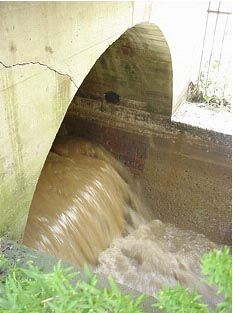The Biggest Sewer
 Our Town downtown
Our Town downtownOctober 16, 2006
From your toilet to the Hudson
Sewage overflow is a phenomenon we’re all too familiar with.
You flush the toilet. Instead of going down, the water level begins to rise. In horror you watch the porcelain bowl fill, hoping beyond hope that the water will recede. The contents circle the bowl, bumping against the lip, looking for a way out. You step back, helpless. Then it happens: water rushes under the toilet seat, and the current carries the bowl’s contents over the seat and onto the floor. You flee the bathroom and jam rolled up towels under the door.
What most New Yorkers don’t know is that’s what happens in our sewer system every time we have a heavy rain. Approximately seventy times a year, storm water fills our sewage pipes, and the system overflows directly into our waterways, raw sewage and all, through 450 combined sewer outfalls around the city. In an average year, about 27 billion gallons of untreated waste water pour through those outfalls into the city’s surface waters, according to Riverkeeper, an environmental advocacy group.
If this system seems incredibly archaic, it is. Construction of our combined sewers began in 1850, before sewer treatment plants existed, when dumping untreated sewage into the river was considered the proper method of disposal. Now the 746 communities around the country that use combined sewers have to figure out how to improve a system built for another era – and shutting down the system for repair is not an option.
The toxic overflow, which carries bacteria and viruses, pesticides, fertilizers, oils, litter and sediment into the rivers encircling Manhattan, is the major contaminant preventing them from being “swimmable,” an ambiguous term whose definition varies from one organization to the next.
A map released by the New York City Department of Environmental Conservation in 2000 as part of its “Urban Watershed Use and Standards Attainment Project” classifies the waters bordering Manhattan as appropriate for fishing, but not for bathing, while the Hudson River north of Manhattan is classified as okay for bathing, as are the waters off the southern shorelines of Brooklyn, Queens and Staten Island.
Even so, the contamination of our waterways has been reduced ten-fold in the past thirty years, according to the Hudson River Foundation’s Health of the Harbor Report. “This decrease,” the report states, “is due mainly to… a strict permitting system for the discharge of these chemicals into our waterways, and improved sewage treatment.”
And it’s got to keep getting better, says the state. A 1994 state mandate orders all cities that use combined sewage systems to establish nine short-term measures, including ensuring that nothing is flowing into the water during dry weather, culling floating matter out of the water, and alerting the public of where the outfalls are, presumably so we can avoid swimming in raw sewage.
The city Department of Environmental Protection now has twenty-three floating barriers and 130,000 catch basins to pick up debris, which is then removed by skimmer vessels, and it has three boats that monitor the outflows on the shoreline. Construction is underway on three massive new tanks that will hold excess sewer outfall until it can be treated, at a cost of $757 million, and three more are being planned. Some of the projects are already done; others, like a storage facility for combined sewer overflow at Newtown Creek, are not scheduled to begin until 2015.
But the required public notification system, if it exists at all, leaves a lot to be desired. Take, for instance, three Hispanic fishermen on the East River esplanade a few blocks above South Street Seaport. They fish most nice days, they say, and they catch blue crabs and all sorts of fish, including bass and perch.
“What kind you want?” one fisherman asks.
Often, they throw the fish back, but sometimes they’ll clean and eat them.
“It’s clean,” the most talkative of the three fishermen asserts. “There’s no more raw sewage coming in here.” He motions upriver. “Not like before.”
According to the State Department of Health, it’s okay to eat the fish you catch in the New York City area, with the exceptions, varying from area to area, of certain types of catfish, eel, shad, perch, and the green “mustard” in lobsters and crabs. It is, however, dangerous to eat more than one river-caught meal a week, the department warns, because they contain contaminants that can build up in your body and, in worst-case scenarios, cause cancer and birth defects. It’s also a bad idea for women of childbearing age or children under 15 to be eating fish from the river at all.
The fishermen don’t know about those warnings. They have no idea they are standing on top of an outflow, or that there are dozens more to their north and south.
In addition to nine short-term stop-gap measures, the city is required by the state to develop a long-term plan to deal with its combined sewer overflows. According to Mark Klein, a spokesman for the New York City Department of Environmental Protection, the department is “fifty percent of the way through the long-term plan.” A PowerPoint presentation given at a recent meeting of the Citizens Advisory Committee of the New York-New Jersey Harbor Estuary Program listed the city’s long-term goals, whuch include the vague pledge to “reconcile water quality standards to highest reasonably attainable uses.”
Does that mean we’ll be able to swim in our rivers? Anyone?
-- Becca Tucker